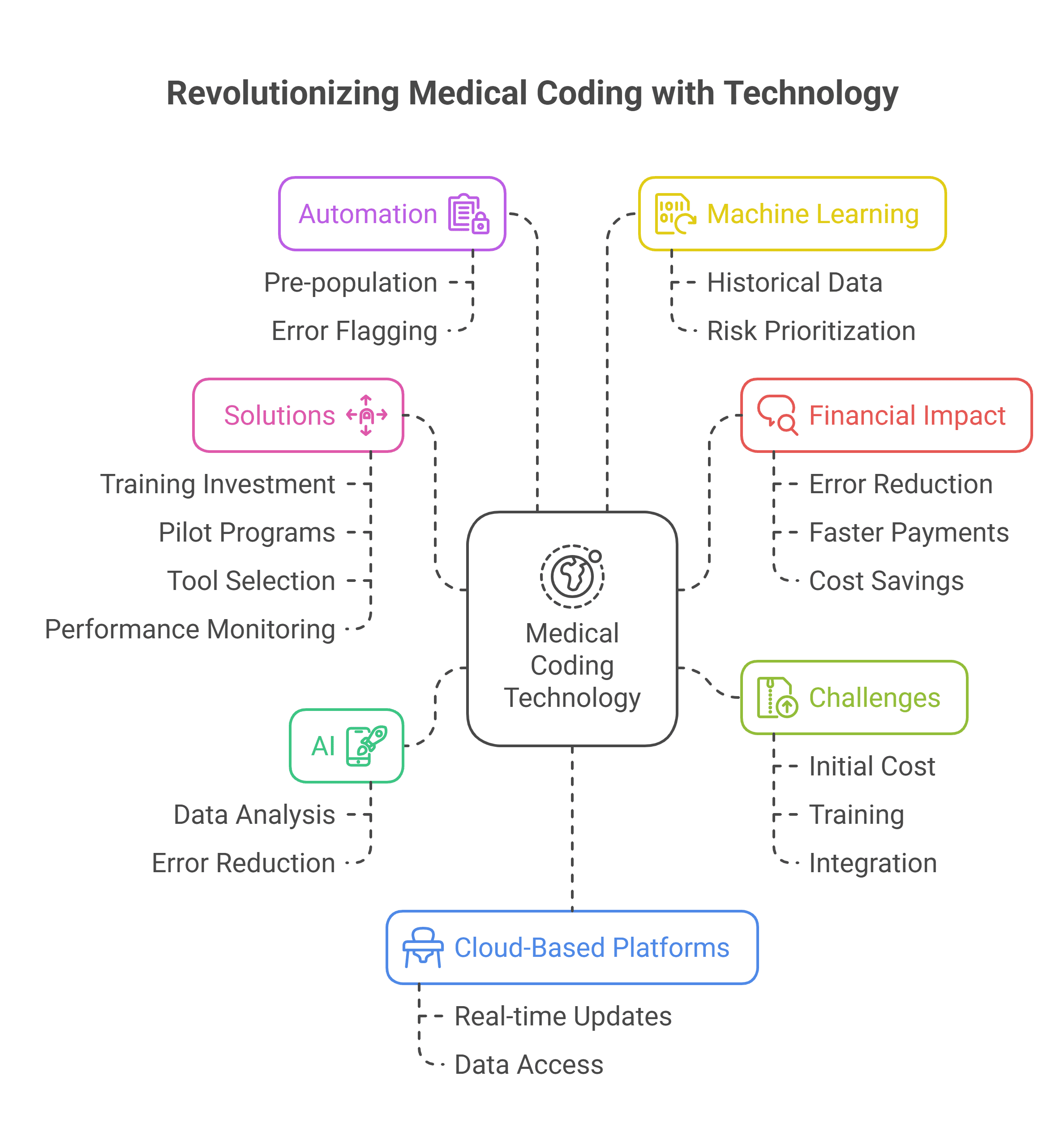On-Demand Outsourcing BPO Services for Healthcare Providers With 24/7 Coverage!
Save up to 70% on staffing costs!
Browse Specialty Staffing ServicesThe Evolution of Medical Coding: Adapting to New Technologies

Medical coding has become an essential part of healthcare revenue management and compliance, yet it continues to be a challenge for many healthcare providers. The industry is undergoing a transformation as new technologies, such as AI, machine learning, and automation, revolutionize how medical coding is done. These tools help clinics improve accuracy, reduce claim denials, and maintain compliance with ever-changing regulations, ultimately improving the revenue cycle.
💬 “Medical coding used to be a paper-based task. Now, it’s all about data entry, software, and technology integration.”
With the growing need for precision, speed, and compliance in healthcare billing, adapting to technological advancements is no longer optional—it’s a necessity.
Why Medical Coding Needs to Evolve ?
The primary reason for the evolution of medical coding is to address the growing complexity of healthcare systems. Outdated, manual processes lead to frequent errors, delays, and financial losses. New technologies offer solutions that make coding more accurate, automated, and scalable.
💬 “Manual coding had too many human errors. Automation has reduced our claim rework by 30%.”
Technological advancements in coding provide the following benefits:
-
Increase Efficiency: Automation reduces the need for manual data entry, minimizing errors.
-
Enhance Accuracy: AI-driven systems detect errors in real time, ensuring better claim outcomes.
-
Improve Compliance: Technologies keep coders up to date with the latest regulations and coding updates.
How Technology is Revolutionizing Medical Coding ?
In the last decade, advancements in technology have drastically changed how medical coding is handled. Some key technologies driving this transformation include:
Artificial Intelligence (AI)
AI tools analyze patient data and recommend appropriate codes automatically. These tools assist coders by identifying the correct codes based on the patient’s diagnosis, reducing human error and increasing the accuracy of claims.
Automation
Automated coding software pre-populates fields, flags potential errors, and speeds up the coding process. This reduces administrative workload and accelerates the revenue cycle.
Machine Learning
Machine learning models predict the likelihood of claim approval based on historical data, helping coders prioritize high-risk claims and minimize denials.
Cloud-Based Platforms
Cloud-based platforms enable real-time collaboration among teams, offering immediate access to patient data, coding standards, and payer-specific requirements.
💬 “Automation has allowed our coding team to focus more on complex cases, while the system handles routine codes.”
The Financial Impact of Adopting New Technologies in Medical Coding
Adopting new technologies in medical coding has clear financial benefits, from reducing rework to speeding up claim submissions. These technologies improve revenue cycle performance by:
-
Reduction in Coding Errors: Minimizing human error decreases claim denials, improving first-pass yield and reducing time spent on reworking claims.
-
Faster Payment Cycles: Automation speeds up the billing process, leading to quicker reimbursements.
-
Cost Savings: Automation reduces the need for additional staffing or overtime, helping clinics save on operational costs.
💬 “We reduced our average claim cycle from 35 days to 20 days after implementing AI-driven coding software.”
Common Challenges in Adopting New Medical Coding Technologies
While the advantages are clear, adopting new medical coding technologies presents several challenges:
-
Initial Cost and Investment: The upfront costs of AI and automation tools can be significant, particularly for small practices.
-
Training and Adaptation: Coders must be trained to use new systems, which can disrupt workflows in the short term.
-
Integration with Existing Systems: Many practices continue to use legacy systems that may not integrate seamlessly with modern coding technologies, requiring system updates or overhauls.
💬 “While AI tools improved our coding accuracy, there was an initial learning curve for our team to adapt.”
How to Overcome These Challenges ?
To successfully implement new medical coding technologies, healthcare providers should follow these steps:
-
Invest in Training: Continuous training ensures that coding teams stay up to date with new tools and industry standards.
-
Start Small: Begin with pilot programs to test the software’s effectiveness before implementing it across the entire practice.
-
Choose the Right Tools: Work with vendors who provide solutions that integrate smoothly with existing systems to minimize disruption.
-
Monitor Results: Regularly evaluate the performance of the new system to ensure it improves coding accuracy and efficiency.
💬 “Starting with a small pilot program helped us ease into the transition and make improvements based on real-world feedback.”

A Smarter Way Forward
As medical coding continues to evolve, embracing new technologies is crucial for maintaining accuracy, efficiency, and compliance. By integrating AI, automation, and machine learning into coding processes, healthcare providers can improve claim accuracy, reduce denials, and optimize the revenue cycle.
What Did We Learn?
The evolution of medical coding is essential for keeping up with the growing complexity of healthcare. Technology, especially AI, automation, and machine learning, plays a key role in improving coding accuracy and speeding up the revenue cycle. By adopting these advanced tools, healthcare providers can reduce errors, minimize claim rework, and achieve faster reimbursements, ultimately improving the revenue cycle. However, challenges such as initial costs, training, and system integration must be carefully managed. The benefits far outweigh the challenges, and with the right approach, healthcare providers can harness technology to streamline their coding processes, reduce administrative burdens, and improve practice efficiency.
What People Are Asking
Q: How does AI improve medical coding accuracy?
A: AI analyzes patient data, automatically suggesting the appropriate codes and flagging errors in real time, improving accuracy.
Q: Will automation replace coders?
A: No, automation assists coders by handling repetitive tasks, while coders remain essential for reviewing complex cases and ensuring compliance.
Q: How long does it take to see financial benefits from new coding technologies?
A: Many clinics see improvements in first-pass yield and reduced rework within the first 3–6 months of implementation.
Q: Is it expensive to switch to automated coding systems?
A: While the upfront cost can be high, the long-term savings and revenue gains usually outweigh the initial investment.
Q: How can I ensure my coding team adapts to new technologies?
A: Provide continuous training and support, and start with pilot programs to gradually transition your team into using new technologies.
Disclaimer
For informational purposes only; not applicable to specific situations.
For tailored support and professional services
Please contact Staffingly, Inc. at (800) 489-5877
Email: support@staffingly.com
About This Blog: This Blog is brought to you by Staffingly, Inc., a trusted name in healthcare outsourcing. The team of skilled healthcare specialists and content creators is dedicated to improving the quality and efficiency of healthcare services. The team passionate about sharing knowledge through insightful articles, blogs, and other educational resources.
 Book a Demo to Build Your Team Today!
Book a Demo to Build Your Team Today!

 Read Case Studies
Read Case Studies 



 Virtual Medical Assistants
Virtual Medical Assistants



